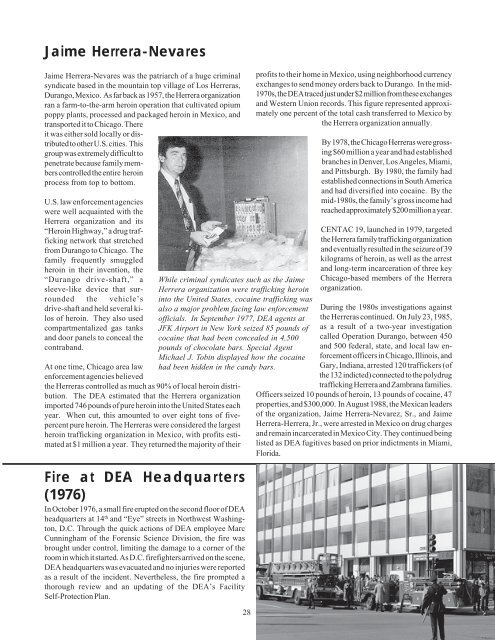Download This File - The Free Information Society
Download This File - The Free Information Society
Download This File - The Free Information Society
You also want an ePaper? Increase the reach of your titles
YUMPU automatically turns print PDFs into web optimized ePapers that Google loves.
Jaime Herrera-Nevares<br />
Jaime Herrera-Nevares was the patriarch of a huge criminal profits to their home in Mexico, using neighborhood currency<br />
syndicate based in the mountain top village of Los Herreras, exchanges to send money orders back to Durango. In the mid-<br />
Durango, Mexico. As far back as 1957, the Herrera organization 1970s, the DEA traced just under $2 million from these exchanges<br />
ran a farm-to-the-arm heroin operation that cultivated opium and Western Union records. <strong>This</strong> figure represented approxipoppy<br />
plants, processed and packaged heroin in Mexico, and mately one percent of the total cash transferred to Mexico by<br />
transported it to Chicago. <strong>The</strong>re<br />
it was either sold locally or dis<br />
the Herrera organization annually.<br />
tributed to other U.S. cities. <strong>This</strong><br />
By 1978, the Chicago Herreras were grossgroup<br />
was extremely difficult to<br />
ing $60 million a year and had established<br />
penetrate because family mem<br />
branches in Denver, Los Angeles, Miami,<br />
bers controlled the entire heroin<br />
and Pittsburgh. By 1980, the family had<br />
process from top to bottom.<br />
established connections in South America<br />
and had diversified into cocaine. By the<br />
U.S. law enforcement agencies<br />
mid-1980s, the family’s gross income had<br />
were well acquainted with the<br />
Herrera organization and its<br />
reached approximately $200 million a year.<br />
“Heroin Highway,” a drug traf-<br />
CENTAC 19, launched in 1979, targeted<br />
ficking network that stretched<br />
the Herrera family trafficking organization<br />
from Durango to Chicago. <strong>The</strong><br />
and eventually resulted in the seizure of 39<br />
family frequently smuggled<br />
kilograms of heroin, as well as the arrest<br />
heroin in their invention, the<br />
and long-term incarceration of three key<br />
“Durango drive-shaft,” a<br />
sleeve-like device that sur-<br />
While criminal syndicates such as the Jaime<br />
Herrera organization were trafficking heroin<br />
Chicago-based members of the Herrera<br />
organization.<br />
rounded the vehicle’s<br />
drive-shaft and held several kilos<br />
of heroin. <strong>The</strong>y also used<br />
compartmentalized gas tanks<br />
and door panels to conceal the<br />
contraband.<br />
At one time, Chicago area law<br />
enforcement agencies believed<br />
into the United States, cocaine trafficking was<br />
also a major problem facing law enforcement<br />
officials. In September 1977, DEA agents at<br />
JFK Airport in New York seized 85 pounds of<br />
cocaine that had been concealed in 4,500<br />
pounds of chocolate bars. Special Agent<br />
Michael J. Tobin displayed how the cocaine<br />
had been hidden in the candy bars.<br />
During the 1980s investigations against<br />
the Herreras continued. On July 23, 1985,<br />
as a result of a two-year investigation<br />
called Operation Durango, between 450<br />
and 500 federal, state, and local law enforcement<br />
officers in Chicago, Illinois, and<br />
Gary, Indiana, arrested 120 traffickers (of<br />
the 132 indicted) connected to the polydrug<br />
the Herreras controlled as much as 90% of local heroin distri-<br />
trafficking Herrera and Zambrana families.<br />
bution. <strong>The</strong> DEA estimated that the Herrera organization Officers seized 10 pounds of heroin, 13 pounds of cocaine, 47<br />
imported 746 pounds of pure heroin into the United States each properties, and $300,000. In August 1988, the Mexican leaders<br />
year. When cut, this amounted to over eight tons of five- of the organization, Jaime Herrera-Nevarez, Sr., and Jaime<br />
percent pure heroin. <strong>The</strong> Herreras were considered the largest Herrera-Herrera, Jr., were arrested in Mexico on drug charges<br />
heroin trafficking organization in Mexico, with profits esti- and remain incarcerated in Mexico City. <strong>The</strong>y continued being<br />
mated at $1 million a year. <strong>The</strong>y returned the majority of their listed as DEA fugitives based on prior indictments in Miami,<br />
Florida.<br />
Fire at DEA Headquarters<br />
(1976)<br />
In October 1976, a small fire erupted on the second floor of DEA<br />
headquarters at 14 th and “Eye” streets in Northwest Washington,<br />
D.C. Through the quick actions of DEA employee Marc<br />
Cunningham of the Forensic Science Division, the fire was<br />
brought under control, limiting the damage to a corner of the<br />
room in which it started. As D.C. firefighters arrived on the scene,<br />
DEA headquarters was evacuated and no injuries were reported<br />
as a result of the incident. Nevertheless, the fire prompted a<br />
thorough review and an updating of the DEA’s Facility<br />
Self-Protection Plan.<br />
28

















